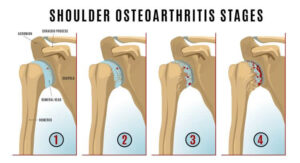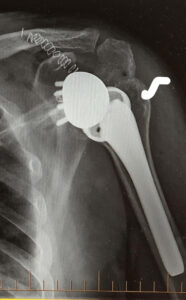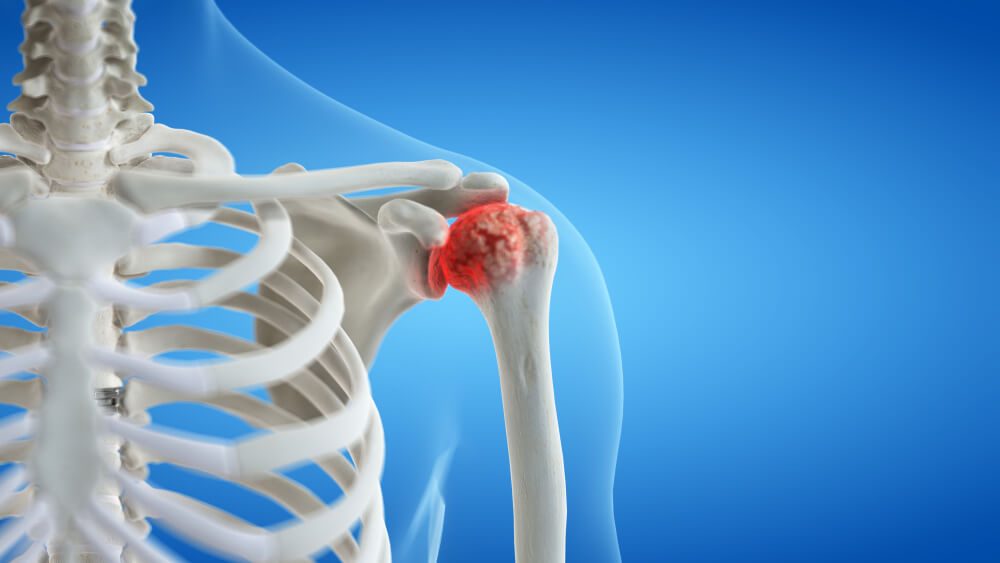Do you ever find yourself wincing in pain as you reach for something on a high shelf or struggle to fasten a button on your shirt? If you do, you’re not alone. Shoulder arthritis can be a difficult condition to manage, making even simple daily tasks feel impossible to complete.
But the good news is, you can find relief from shoulder arthritis. Whether your discomfort is a minor annoyance or a constant nagging pain, we’ve got you covered with a range of effective pain relief strategies that can be used to create a tailored treatment approach to keep your pain under control.
Understanding Shoulder Arthritis
Shoulder arthritis stems from gradual wear and tear of the cartilage that cushions the joint, resulting in discomfort and reduced mobility.
There are several different types of shoulder arthritis, each with its distinct characteristics. Rheumatoid arthritis is an autoimmune condition causing inflammation in the joint lining, while osteoarthritis arises from the natural aging process, leading to the breakdown of joint cartilage. Post-traumatic arthritis develops after an injury or shoulder surgery, while rotator cuff tear arthropathy is linked to long-standing rotator cuff tears. Avascular necrosis, however, occurs due to insufficient blood supply to the bone, causing it to weaken and collapse.

Recognising the symptoms of shoulder arthritis is crucial for timely intervention. Initially, you may experience stiffness in the shoulder, making it challenging to move freely. You may also notice grinding, clicking, or cracking sounds when you move your shoulder, but most significantly, you may experience pain in all areas of the shoulder that, in severe cases, may radiate to the elbow and wrist.
Range of Motion Exercises For Early Intervention
When it comes to managing shoulder arthritis, range-of-motion exercises are your first line of defence. Incorporating these exercises into your daily schedule can help to preserve mobility, reduce stiffness, and most importantly reduce the pain you experience in the shoulder joint.
Specific exercises tailored for shoulder arthritis can make a significant difference in your comfort and functionality. These exercises focus on gently stretching and strengthening the muscles around the shoulder, promoting better joint stability. Some common exercises include pendulum swings, wall walks, and towel stretches.
Consistency is key to reaping the benefits of these exercises. Aim to incorporate them into your daily routine, starting with just a few minutes each day before gradually increasing the intensity as your comfort level allows. However, safety should always be a priority. Start with gentle movements and consult an experienced shoulder specialist for guidance. Remember, these exercises should never cause you pain; if they do, it’s essential to reassess your approach.
Applying Heat and Ice
If you’re searching for a cost-effective and highly efficient method of relief from the pain associated with shoulder arthritis, don’t look beyond the application of either heat or ice.
Using Ice To Manage Pain
When it comes to reducing inflammation and providing acute pain relief after activity, ice can be your best asset. Applying ice to your shoulder 20-30 minutes at a time can help constrict blood vessels, diminishing swelling and soothing discomfort. This is particularly effective after engaging in exercises or activities that may exacerbate your shoulder pain.

Using Heat To Manage Pain
However, some patients find the application to be the best pain reliever for their shoulder arthritis. Heat plays a vital role in relaxing muscles and preparing your shoulder for exercise, and it can also increase blood flow, promoting the healing process and alleviating muscle tension. You may consider using a warm compress or a heating pad for 15-20 minutes before any required exercises to manage the pain you experience.
Injections For Shoulder Arthritis Pain
If you don’t receive adequate pain relief from more conservative measures, you may consider either cortisone or hyaluronic acid injections to manage your pain.
Cortisone Injections
Cortisone is a numbing agent, and its injection is designed to provide immediate pain relief and help your shoulder specialist isolate the exact area of pain. Once the numbing effect wears off, you might experience some soreness in the joint until the cortisone takes full effect, but icing the shoulder for a day or so after the injection can alleviate this discomfort. Experienced shoulder surgeons recommend limiting these injections to a few each year, and if you’re considering surgery in the near future, cortisone injections may increase the risk of infection.

Hyaluronic Acid
Alternatively, hyaluronic acid, a natural lubricant found in the human body, can provide relief by injecting it into the shoulder joint. This injection can alleviate pain for up to two years in some cases, although complete and extended pain relief is uncommon. It’s a safe and well-tolerated option for managing shoulder arthritis.
When considering these injections, consult your healthcare provider to discuss the best course of action based on your condition and needs. Keep in mind that while injections can provide relief, they are part of a broader strategy for managing shoulder arthritis effectively.
Considering Surgery: When Non-Invasive Strategies Aren’t Enough
When conservative approaches fall short in managing shoulder arthritis, surgery may become a viable option. There are three potential types of surgeries that your specialist may recommend:
Arthroscopic Shoulder Debridement
This minimally invasive procedure uses a small camera to remove damaged tissue and debris from the shoulder joint. It’s recommended for patients with lower grades of arthritis and is not typically advised for bone-on-bone situations. Recovery is generally quicker compared to more extensive surgeries, but it’s important to recognise that it is not a permanent solution, with relief typically lasting 1-2 years.
Total Shoulder Replacement
Ideal for more severe cases of bone-on-bone shoulder arthritis, this procedure replaces both the ball and socket parts of the shoulder joint with artificial components. It effectively relieves the pain associated with arthritis and has demonstrated long-lasting results over the years.

Reverse Total Shoulder Replacement
In this procedure, the ball and socket sides of the joint switch places. It is commonly used when there is a rotator cuff tear in the shoulder combined with arthritis. While this option is specialised and reserved for complex cases, it can offer substantial relief and improved function.
When considering surgery, consult with your chosen shoulder surgeon to determine the most suitable option based on your specific condition and needs. Surgery is typically reserved for cases where non-invasive methods have proven ineffective, and it’s essential to be well-informed about the procedure, recovery, and expected outcomes.
Minimise The Pain You Experience From Shoulder Arthritis
Managing shoulder arthritis effectively often requires a combination of strategies, from exercises and heat and ice application to injections and, in some cases, surgery. However, the journey to pain relief and improved quality of life always begins by seeking professional guidance. Don’t let shoulder arthritis hold you back any longer. Take the proactive step and consult an experienced shoulder specialist who can create and guide you through a personalised pain management program. Your path to a more comfortable and active life awaits.


